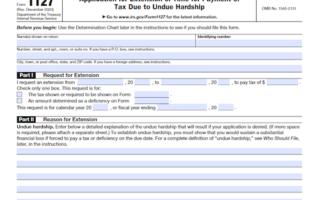If you are the fiduciary of an estate or trust, you may have to use Form 1041-V when sending payments for the balance due on their 2022 taxes. It allows for processing of payments more efficiently, though it is not required. Learn more about how Form 1041-V works and how to prepare payments and send them in.
What is Form 1041-V?
Form 1041-V is a form you can use to provide additional information to the IRS when sending payments for balance due on the estate’s or trust’s 2022 Form 1041. Using the form will ensure more accurate and efficient payment processing. The form includes details such as the estate’s or trust’s employer identification number, name, and address, as well as the full name and title of the fiduciary submitting the form. Payments must be made via check or money order, payable to the United States Treasury, and not in cash. Specific instructions and limitations apply to checks for $100 million or more. On submission, ensure the return, payment, and form are not stapled or attached to each other and place them all in one envelope to be mailed to the appropriate address.
IRS Form 1041-V – Who Needs to Fill It Out?
IRS Form 1041-V is for trust and estate tax returns and needs to be filled out by the fiduciary of the estate or trust. It is a statement you send in with a check or money order, letting the IRS process the payment more accurately. You can choose to pay electronically, so you won’t need the Form 1041-V. Lines 1-5 of the form should be filled out and both the name of the estate or trust and its EIN should be accurately written on the check or money order. Single checks for amounts over $100 million need to be split into two checks – electronic payments are still accepted for these amounts. Finally, don’t staple any other forms or payments, just mail them loose in an envelope.
Step-by-Step: Form 1041-V Instructions for Filling Out the Document
Form 1041-V is a statement sent with a check or money order as payment for any balance due on Line 28 of the trust’s or estate’s 2022 Form 1041 (Tax due). It is strongly encouraged to use Form 1041-V to ensure prompt and accurate processing. If paying electronically, this form is not required. To fill out the form, provide the trust or estate’s EIN, total amount due, name of the trust or estate, and contact information. When preparing the payment, make the check or money order out to United States Treasury and include the trust or estate’s EIN and “2022 Form 1041” on the check or money order. Amounts of $100 million or more must be sent in multiple checks of less than $100 million each. Lastly, detach Form 1041-V along the dotted line, do not staple or annex and mail to the appropriate address provided.
Below, we present a table that will help you understand how to fill out Form 1041-V.
| Information Required for Form 1041-V | Details |
|---|---|
| Purpose of Form | Statement sent with a check or money order for balance due on Line 28 of Form 1041 |
| Payment Instructions | Make check or money order out to “United States Treasury” with EIN and “2022 Form 1041” |
| Amount Limits | If over $100 million, send in multiple checks of less than $100 million each |
| Detach and Mail | Detach Form 1041-V along the dotted line, do not staple or annex, and mail to the appropriate address |
Do You Need to File Form 1041-V Each Year?
Yes, Form 1041-V must be filed each year for the estate or trust. As the fiduciary of the estate or trust, you should use Form 1041-V in order to allow the IRS to process the payment more accurately and efficiently. However, you may choose to pay any balance due with an electronic payment, in which case Form 1041-V is not required. Be sure to include your name, the estate or trust’s EIN, the amount being paid, and the correct year (2022) when filling out the form. When submitting the payment, make the check or money order payable to “United States Treasury” and include the estate or trust’s name and EIN. You must also enter the amount on the right side of the check correctly. Single checks or cashier’s checks for amounts over $100 million will not be accepted, so you may need to send two or more payments.
Download the Official IRS Form 1041-V PDF
On the official IRS website, you will find a link to download Form 1041-V. However, to make it easier for you, we are providing the link in our article, which comes directly from the official irs.gov website! Click to download: Form 1041-V
Sources:




